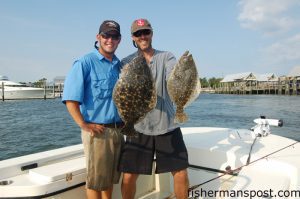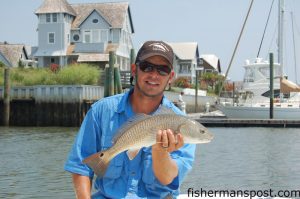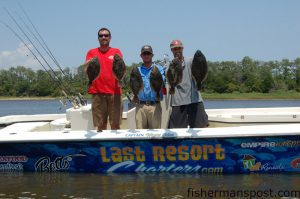A Curse Reversed

Capt. Wayne Crisco, of Last Resort Charters, and the formerly-cursed Gary Hurley, of Fisherman's Post Newspaper, with a brace of flounder Hurley hooked on back-to-back casts in a marina near Southport. The flatties fell for live peanut pogies on Carolina rigs.
“The Flounder jinx is gone!” proclaimed Fisherman’s Post Publisher Gary Hurley through peals of triumphant laughter. I wasn’t as positive, but had to admit the two fish he’d just brought to Capt. Wayne Crisco’s waiting net, a fat three pounder followed by an even prettier four pound-class fish on the next drop, were a definite step in the right direction for a man whose flatfish handicap has plagued him the entire five years I’ve known him.
The turnaround began last year, not coincidentally while we were also fishing with Wayne during the Flat Bottom Girls tournament, when Gary landed back-to-back citation flatties along with a handsome portion of the over a dozen caught by our crew that day. This was the beginning of a sea change from the boss I’d known for years, who once had to wait for an October grouper trip to land his first keeper flatfish of the year. And he was also generous enough to step off the boat after a slow day of fishing several years ago, enabling the three remaining members of the team to land over 30 flounder in little more than an hour.
Gary was quick, however, to pass the credit for his maturation into a bona fide flounder pounder. “I’m a believer!” he continued, his fervor matching that of any new religious convert. “Wayne Crisco made me a believer!”
Wayne, who runs Last Resort Charters out of Surf City, has earned his status as a flounder sage, never failing to produce on a trip we’ve fished together, and he’s been the go-to Fisherman’s Post ringer in tournament competition for the last several years.
Over that time, I’ve picked up a good bit of knowledge from Wayne on the flatfish game that’s certainly improved my personal flounder fishing (on leader length, avoiding toadfish, bait selections, and much more), and apparently Gary was feeling the same.
Wayne meets most of his trips near his hometown of Surf City, but he’s not shy about traveling to put people (and himself, come tournament time) on more and bigger flounder, and today we’d met up at the Wildlife Creek boat ramp in Southport, where Wayne felt a lot better about our flounder fortunes. Wayne’s no stranger to Southport, as he grew up there, and apparently Southport’s no stranger to him as, repeatedly, we ran into people on land and water with good things to say about Wayne, and particularly his flatfishing skills.
Our intention had been to run out the mouth of the Cape Fear and start our day on some nearshore structure, returning to the river as the morning progressed, but Wayne had some doubts even before we were in the boat.
“It’s blowing pretty good,” he explained while launching his freshly-wrapped 23’ May-Craft bay boat. “We’ll take a look, but I don’t know if we’re making it out there today.”
The breeze barely riffled the protected surface of Wildlife Creek as we putted through the fleet of anchored sailboats, Wayne on the bow tossing a cast net at seemingly random pogy flips marring the calm. After a few minutes, we finally located the school we were looking for, and the net looked momentarily like a disco ball as it sunk, hundreds of pogies flashing as they protested their mesh confinement. With easily enough pogies in the well, we tossed some of the haul back overboard. Wayne took the helm, and we cruised out into the ICW, downtown Southport coming and going as we headed out into the Cape Fear. A quick look at the river mouth made it clear that this was not a nearshore day for a bay boat, and Wayne spun the May-Craft around for calmer, yet hopefully fishy waters.
“I’ve been fishing this spot a lot lately,” the captain explained as we glided through the entrance to a local marina. “There’s some big fish here, but there’s also just a ton of quality eating fish—2-3 pounders.”
Wayne’s marina technique, which I’ve seen the results of on several occasions, involves power drifting, using the boat’s motor to control the boat and slowly cover ground until fish are located.
We’d barely made it inside the protection of the marina when the technique again proved itself.
“There he is,” Gary exclaimed just seconds after his egg sinker had hit the bottom 10’ below.
After a brief waiting period, he set the hook, rod taking a substantial set before a quick round of headshakes below resulted in a pulled hook.
“Do you like to open the bail and let them eat?” Gary queried Wayne, obviously eager to avoid a repeat of his first drop.
“Nope,” he replied, impaling a pogy of his own on a medium spinning rod. “If you get a bite and we’re moving away, let me know and I’ll back down on him and let him eat. Keep your line tight and kind of follow him with the rod tip. I like to feel what’s going on the whole time.”
Gary nodded and prepared to cast back to where his fish was enjoying a free meal, but Wayne motioned him down.
“Drop it straight down beside the boat,” he said, directing Gary to send his Carolina rig into the depths off the starboard gunwale. “I’ll drag it right back by him.”
Though it appeared to be a slightly smaller fish, instant gratification was the name of the game, as Hurley followed Wayne’s advice, dropping his rod tip back, and setting the hook on what was ultimately his inaugural three pounder.
A quick celebration ensued before the two-casts, two-bites promise of fast action had the three of us dropping lively pogies back to the bottom while Wayne bumped the 150 Yamaha in and out of gear.
Within moments, I looked up to see an even more substantial bend in Gary’s spinner, and Wayne holding a net in anticipation.
Once the four-pounder hit the deck, Gary was conspicuously elated, and since Wayne and I had yet to hook up, we were concerned about the fate of our $1 big-fish wager on the day.
“That’s a dollar for the first fish? That’s what we said?” Gary said, a grin spreading across his face.
“Don’t think so,” Wayne quipped back, clearly concentrating on adding his own fish to the box.
As luck would have it, I was the next to feel the distinct thump of a flounder laying down for a meal and followed the fish with my rod tip, eventually snapping it up to the telltale resistance and head-shaking of another solid flatfish.
The rod’s pressure overcame the flounder’s will after a short back and forth, and Wayne was soon sliding the net under another solid 3 lb. class flattie.
“I’m going to let you get him off,” the captain said with a grin. “I’m trying to catch one, and you guys are killing me.”
I didn’t have time to slide that night’s dinner into the cooler and hook another bait before Wayne was bowed up with a fish en route to the surface. I quickened my efforts to untangle the Carolina rig from the mesh bag of the landing net, pulling it off just in time to slide the hoop under a triplet of my fish and Gary’s first.
The three of us couldn’t stop commenting on the quality of these first fish we’d put in the boat, the smaller ones 18-19” and as thick and wide as I’ve ever seen at that size. Apparently there’s no shortage of flounder food in the Cape Fear.
“We’ve already got some meat in the boat,” I couldn’t help commenting, a mere 20 minutes into our fishing day.

Capt. Wayne Crisco, of Last Resort Charters, with a 22" red drum he muscled out from under a dock after it fell for a live peanut pogy in a marina near Southport.
“Oh, we’ll have a mountain of meat by the end of this day,” Wayne declared with confidence. “That’s good because I’ve promised some people some fish.”
With similar promises to my circle of friends, a mountain of flounder fillets sounded good, and I shut my mouth and continued to fish.
As we continued to slowly move through the marina, our writhing pogies attracted the attention of several more fish, and Wayne and Gary each made additional deposits to the rapidly growing flounder account in Wayne’s 100 qt. Igloo.
Not one of the fish was even close to needing measurement, as they all fit Wayne’s quality-eater prophesy, thick fish in the 2-3+ lb. class.
As we continued slowly working our way through the marina, it appeared Wayne had a mission beyond simply meandering through the basin and putting fish in the boat.
“We’re working our way over there to a deep hole in front of that dock,” the captain explained, using a spinning rod to gesture at a large fixed dock in line with our path. “If you get a bite over there, tighten up on your drag because it might be a nice drum and he’ll get into the dock. The flounder over here are liable to be nice ones, too.”
“Watch this bottom drop off,” he continued, bringing my attention to a steep slope going from 8-15’ as it scrolled across the depthfinder.
Our first few casts at the dock played out Wayne’s predictions perfectly. Gary popped another nice flounder, while Wayne and I both hooked what must have been drum. Wayne’s fish gave him a moment’s drama, running around a piling and forcing the captain to follow with his rod. It looked like perhaps there was a glimmer of hope as Wayne appeared to turn the fish, but a second burst around a well-barnacled piling parted the line.
Mine picked up my bait right next to a piling, and gave no quarter whatsoever, using the piling to cleanly slice my leader less than a second after hookup.
Hastily re-rigging, Wayne and I were back in the game before Gary could add another flatfish to his lead. However, not long after our baits hit the bottom, the once-cursed flatfisherman struck again.
“Who are you today, Gary Hurley?” he exulted, again unable to refrain from laughing. “Thank you, Wayne!” At this point, and with only one fish on the board myself, I had to begrudgingly agree that the man’s flounder fortunes were indeed in an upward turn.
Over the course of the next hour, we added another half-dozen flatties to the cooler, with one of us nearly always in ‘negotiations’ with a slow-dining fish, reeling one in, or netting one for someone else. Still, with the better part of a dozen fish on ice, we hadn’t had to measure a single one—a 100% keeper ratio, and without a fish under 2 lbs. The bite, however, took a sharp downturn as the morning wore on.
Wayne, of course, knew why.
“I don’t think the current really matters to the flounder,” Wayne explained, talking out a new strategy, “except for one thing—you’ve got to have some. I don’t really care for fishing a slack tide, and it’s dead in here. Let’s go fish some docks around Southport, then come back here once the tide gets moving again.”
As Wayne throttled out of the marina and into the river, it became apparent the southwest wind had come on even harder; confirming our decision that to stay inshore was a good one.
After Wayne blasted the May-Craft through the steep chop created by that wind against the current in the river channel, he had me on the bow deploying the anchor for the first time that morning.
“This dock’s got a great drop-off in front of it,” Wayne explained as the boat drifted back on the anchor line. “My dad lost a real big fish here during a tournament last weekend.”
“Max, cast right there into the corner of that dock,” he continued after I’d baited a rig. “That’s where that big fish was laying.”
Sadly, I didn’t end up hooking the big fish, but Wayne and Gary quickly added another pair of fish to the box—including our smallest fish to that point, a 16” fish that still didn’t require the measuring tape.
After a short lull in the action, Wayne decided to prospect a few more docks, and we began running into more people who knew and respected the man’s flounder skills.
After I became somewhat concerned about a boat closing in on us extremely slowly, Wayne looked back and smiled.

Max Gaspeny, Capt. Wayne Crisco, and Gary Hurley with six healthy 2-4+ lb. Cape Fear River flounder that fell for live, Carolina-rigged peanut pogies in a marina near Southport.
“That’s my preacher,” he explained, hailing the holy man over. A quick comparison of our catches left me with no doubt I was on the right boat.
“Can’t go anywhere without seeing you!” I heard a few minutes later, and a pair of anglers in a well-rigged jon boat were also eager to compare notes, again without nearly the same success we’d had over the morning.
I think Wayne became fed up with the lack of activity on the docks we’d been fishing, and he decided to head back to the marina that had been so generous to our cooler.
“You guys want to go catch some?” Wayne queried of his friends in the aluminum boat, and they jumped on the opportunity, quickly stowing their gear and falling in behind the May-Craft for the brief ride back to our spot.
The tide had yet to come around and begin flowing again, but Wayne explained that a tide was slower to do so in the confines of the marina.
“Just drift it and move around a little bit with the motor,” he instructed to our buddy boat, and we parted ways, giving them plenty of room to maneuver through the protected basin.
Though the bite wasn’t as red hot as it’d been that morning, both Gary and Wayne proceeded to add a few more fish to the box, and I finally followed suit, landing our smallest fish of the day, still a 14.5” keeper.
Wayne also made good on his prediction about the reds, landing a 22” fish from under the dock where we’d been cut off earlier.
“This ain’t like those fish that we had earlier,” he said while I snapped a few photos of the bronzed fish. “They had some shoulders!”
I chose to believe the same about the three others that manhandled my tackle over the next few minutes, all slicing the line or leader on pilings despite my best efforts to stop them on 30 lb. braid.
After deciding that we’d made good on the flounder sage’s “mountain of meat” prophecy, we decided to head back to Wildlife Creek early that afternoon to return to Wilmington and begin cleaning fish. Wayne, always hungry for more, decided to go back out for a late afternoon session.
In addition to terrorizing flatfish populations from New River Inlet to Southport and beyond, Capt. Wayne Crisco fishes for just about everything else in the inshore and nearshore waters, including speckled trout, red drum, sheepshead, spanish mackerel, and more.
To find out more information about Last Resort Charters or to schedule a trip, give Wayne a call at (910) 465-0611 or check out his website at site.lastresortcharters.com online (don’t type in the www).
